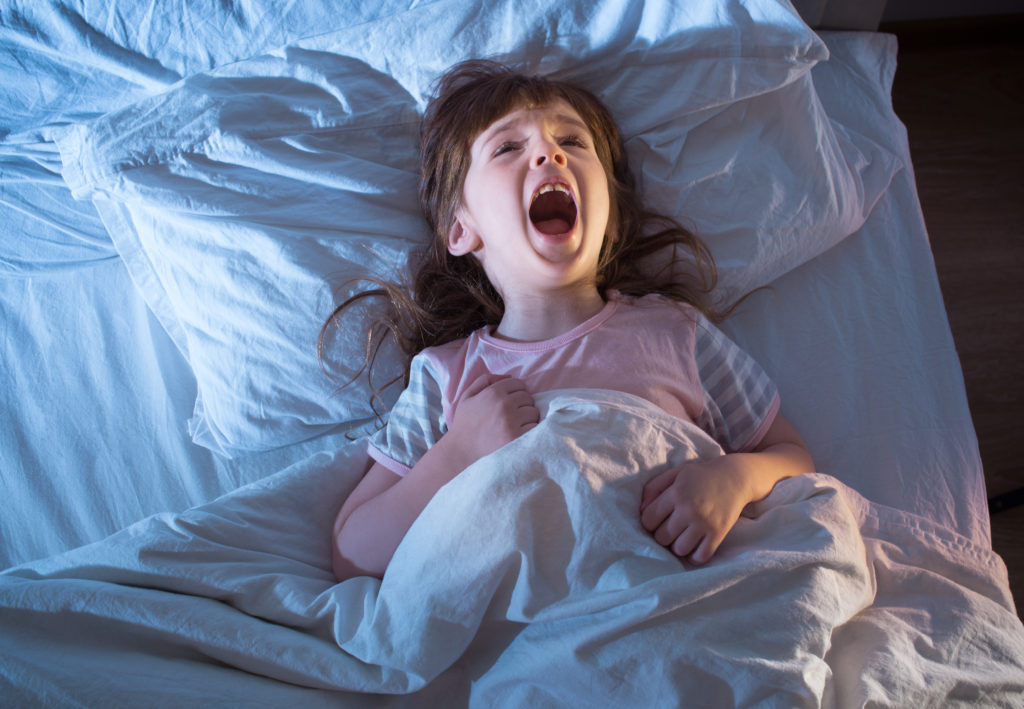I used to dread going to bed when we lived in my lovely heritage apartment in Vancouver. Every night, about two hours after falling asleep, I would be startled awake by the most blood-curdling, agonizing screaming from the woman next door. Her window faced ours, and she sounded as though she was being murdered in her sleep almost every night. I wondered why no one would wake her up or help her. I have since learned that this would not have done much good as she was having night terrors.
So many people I’ve spoken with about this have suffered the same thing with their children. Night terrors are fairly common in very young children, affecting 20-40% of children under age 3, and 3-14% of school age children, but just 2% of adults (APA 2013). In a typical episode, parents will put their child quietly to bed only to hear them thrashing and screaming in terror about three hours later. The kids were hard to fully wake up, disoriented and confused, often with little or no memory of the incident in the morning.
Night terrors are often mistaken for nightmares. At a recent talk I gave about nightmares, most of the questions were actually about night terrors – from desperate parents wanting to know if there was something they could do about them. I treat nightmares, not night terrors, but I did some investigation, and there are a few things to know and to do that can help. First and foremost, know that they are generally benign and kids usually grow out of them.
Who Has Night Terrors?
Before I get into some of the ways you can help your child with their night terrors, it helps to understand what they are, who has them and why. A thorough survey of the literature suggests that although the exact cause is not well understood, genetic, developmental, environmental, psychological and organic factors can all play a part.
Night terrors most common in early childhood. A longitudinal study (Petit et al., 2015) of 1,940 children from Quebec found that 34% of children aged 18 months experience night terrors, 13% at age 5, and 5% at age 13. A recent review (Leung et al., 2020) found the peak may be later, at age 5-7 years. Either way, sleep terrors typically start at a very young age and stop at adolescence. It’s rare that the condition continues into adulthood – although for some it can switch to sleepwalking.
Sleep terrors are more common under a number of conditions that can be controlled, at least to some degree, such as: sleep deprivation, going to bed with a full bladder, emotional stress, anxiety (including separation anxiety), bullying, a noisy sleeping environment and excessive alcohol or caffeine. Other factors associated with this parasomnia include: febrile illness (unexplained fever), ADHD, autism, epilepsy, sleep apnea and PTSD. Some medications, especially those that are sedative, can lead to night terrors because they increase the duration of non-REM, the deep sleep stage in which these episodes occur.
It bears repeating the while night terrors are very distressing and can disrupt sleep for both children and their parents, they are not considered dangerous. They warrant clinical attention only if they are severe enough to disrupt daytime functioning. If you are considering consulting a doctor, keep a sleep diary and track BEARS. Not the big furry animal, but the 5-item assessment tool for children with sleep problems (Owens & Dalzell, 2005):
- B: bedtime issues
- E: excessive daytime sleepiness
- A: night awakenings
- R: regularity and duration of sleep
- S: snoring
What Are Night Terrors?
In a typical episode, the child will sit bolt upright or even jump out of bed, heart racing, screaming in terror. They may speak, but what they say will be confused and incoherent because although they appear to be awake, they are in a hybrid sleep-wake state. They will be difficult to wake fully because these episodes occur during very deep (slow-wave) sleep. It’s best not to wake them up during an episode, and typically they won’t recall a thing in the morning.
Night terrors are distinguished from nightmares because they happen in the first half of the night associated with the deeper (stage 3 and 4) of non-REM sleep, while nightmares mainly occur in the second half, and are associated more with REM sleep and dreaming. Nightmares are clearly recalled in vivid detail, and those who have them tend not to thrash around and scream.
Night terrors are much more common in children. When they continue into adulthood, they look a bit different. While two-thirds of children have no recollection after episodes of night terrors or sleepwalking, the same proportion of adults do recall at least one experience and remember their episodes about half the time (Castelnovo, et al., 2021). For adults, night terrors appear to be more of a dissociative experience, and can be accompanied by hallucinations.
What you can do about night terrors
While none of the suggestions below work all the time, there are a number of things you can try to reduce or even eliminate night terrors. Excellent sleep hygiene (such as regular bedtimes; limiting screen time, no food and drink before bed, especially sugar and caffeine; dark, cool quiet bedroom; and wind-down rituals like story time) can all help reduce night terrors. Parents can also do their best to limit stresses on kids who have night terrors – things like bullying and separation anxiety might be addressed. Interestingly, psychological factors are found to be mostly associated with night terrors in teens and adults, but not children.
Wake-up treatment. One treatment that has met with some success is to wake a person up about half an hour before they would typically have an episode. If you do this for two weeks, it can break the cycle and stop it from recurring. In some cases, however, the episodes simply start occurring later in the night.
Co-sleeping. One interesting paper (Boyden, Pott & Starks, 2018) suggests that sleeping with your child stops night terrors, especially with very young children. The authors say that evolution did not design humans to sleep alone when very young and that “night terrors are the result of an environmental mismatch between evolved behaviour and the modern cultural practice of solitary sleeping.” This solution has not been empirically tested, but anecdotally, it appears to work for many.
The bottom line is that while night terrors can seem extreme, they are usually benign and your child will experience them less and less over time. There are a number of things you can try, such as good sleep hygiene, limiting stress, waking them prior to an episode and co-sleeping. To all those exhausted parents reading this, I hope it has been of some help.
References
American Psychiatric Association. (2013). Diagnostic and statistical manual of mental disorders (5th ed.). Washington, DC: Author.
Davey, M. (2009). Kids that go bump in the night. Australian Family Physician, 30, 290- 294.
Ekambaram, V., & Maski, K. (2017). Non- rapid eye movement arousal parasomnias in children. Pediatric Annals, 46, e327-e331. doi:10.3928/19382359-20170814-01
Golbin, A.Z., Guseva, V.E., & Shepovalnikov, A.N. (2013). Unusual behaviors in sleep as “compensatory” reactions aimed at normalizing the sleep–wake cycle. Human Physiology, 39, 635-641. doi:10.1134/ S0362119713060042
Ivanenko, A., & Johnson, K.P. (2016). Sleep disorders. In M.K. Dulcan (Ed.), Dulcan’s textbook of child and adolescent psychiatry (2nd ed.). Arlington, VA: American Psychiatric Publishing.
Laberge, L., Tremblay, R.E., Vitaro, F., & Montplaisir, J. (2000). Development of parasomnias from childhood to early adoles- cence. Pediatrics, 106, 67-74. doi:10.1542/ peds.106.1.67
Leung, A. K. C., Leung, A. A. M., Wong, A. H. C., & Lun Hon, K. (2020). Sleep terrors: an updated review. Current Pediatric Reviews, 16(3), 176-182.
Murphy, P.J., Frei, M.G., & Papolos, D. (2014). Alterations in skin temperature and sleep in the fear of harm phenotype of pediatric bi- polar disorder. Journal of Clinical Medicine, 3, 959-971. doi:10.3390/jcm3030959
Nguyen, B.H., Pérusse, D., Paquet, J., Petit, D., Boivin, M., Tremblay, R.E., & Montplaisir, J. (2008). Sleep terrors in children: A prospective study of twins. Pediatrics, 122, e1164- e1167. doi:10.1542/peds.2008-1303
Petit, D., Pennestri, M.H., Paquet, J., Desautels, A., Zadra, A., Vitaro, F.,…Montplaisir, J. (2015). Childhood sleepwalking and sleep terrors: A longitudinal study of prevalence and familial aggregation. JAMA Pediatrics, 169, 653-658. doi:10.1001/ jamapediatrics.2015.127
Salazar, F., Baird, G., Chandler, S., Tseng, E., O’Sullivan, T., Howlin, P.,…Simonoff, E. (2015). Co-occurring psychiatric disorders in preschool and elementary school-aged chil- dren with autism spectrum disorder. Journal of Autism and Developmental Disorder, 45, 2283- 2294. doi:10.1007/s10803-015-2361-5
Silvestri, R., Gagliano, A., Aricò, I., Calarese, T., Cedro, C., Bruni, O.,…Bramanti, P. (2009). Sleep disorders in children with attention- deficit/hyperactivity disorder (ADHD) re- corded overnight by video-polysomnography. Sleep Medicine, 10, 1132-1138. doi:10.1016/ j.sleep.2009.04.003
Wolke, D., & Lereya, S.T. (2014). Bullying and parasomnias: A longitudinal cohort study. Pediatrics, 134, e1040-e1048. doi:10.1542/ peds.2014-1295
Are you a parent concerned about the frequency and intensity of your child’s bad dreams? Should you be concerned?
Learn more about Nightmare Relief for Everyone designed by nightmare expert Dr. Leslie Ellis, this self-paced user-friendly and accessible online course covers the very latest in science and research about what nightmares are, and what they’re not. Leslie offers some simple steps you can take to get some relief from nightmares and other nocturnal disturbances – both for yourself and for others, including your children.






